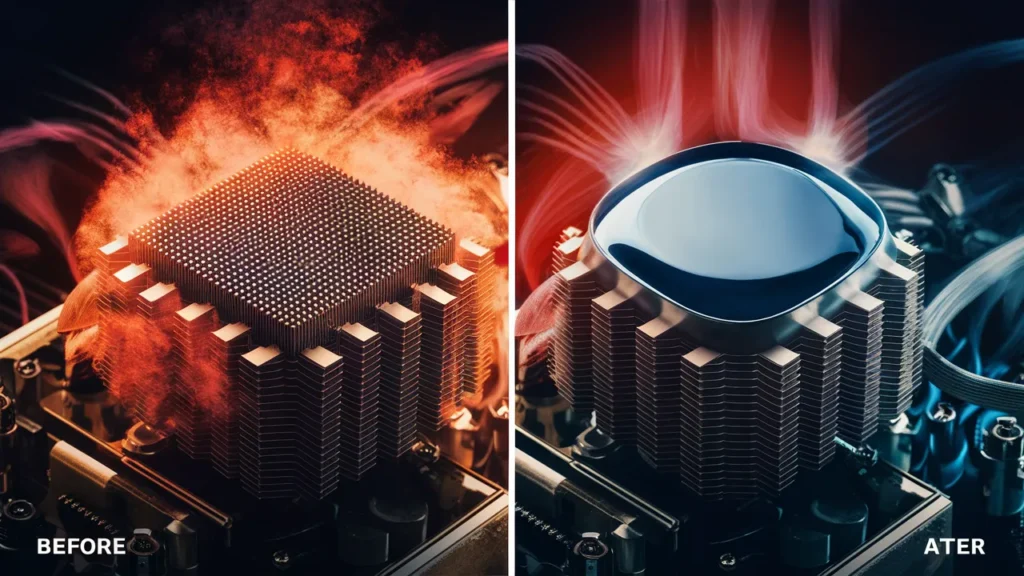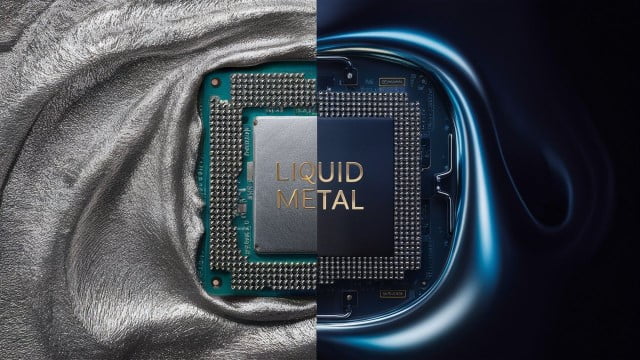Is your computer running hot like a summer sidewalk? Do your fans sound like a jet engine trying to take off? If so, your computer might be overheating! Don’t worry, you’re not alone.
Everyone else feels the same way. Many computers can barely maintain a good temperature, especially during hard games or in times of overload.
However, just turn your mind over, tech explorer! This article will give you enough information to prevent a CPU’s overheating, thus avoiding sudden shutdowns or further damage. Today we will explore the wonderful world of CPU cooling, to find the best solution for your specific needs.
How CPU important for cooling?
Imagine your computer just like a bustling city. The main function of the central processing unit is to supply the necessary power for performing operations, counting data, and generally ensuring that everything runs smoothly. Just like an electric power plant that produces heat, so does the CPU. This heat should be effectively taken away to avoid CPU heat up as a cooling tower is being used in a power plant.
An excess of heat creates several issues for your computer equipment. In extreme conditions, it could even destroy the CPU due to its crashing and speed mismatching (like your city has a power failure!). That is why good CPU cooling would always be the way to keep your computer in good health, happy, and intact.
The Thermal Bridge: How Thermal Paste Gets Heat Moving
We know that CPUs produce a lot of heat. We’re going to show that just like any city that generates energy needs a transport network the CPU which is the source of power needs a way to transfer the generated heat away from it. It’s at this point that thermal paste is used. Compared with thermal paste a thermal conductor is a special kind of substance that is applied between the CPU and the heatsink. The heatsink, coming with fins or a fan, works like a big radiator, and the airflow helps to exchange it for a cooler outside.
But here’s the catch: Such that the metal of the CPU and heatsink is not entirely without naturally occurring marks on their surfaces. Microscopically, the surface is imperfect as the coating is not applied perfectly, and there are gaps between the coating and the substrate. The air is a terrible conductor of heat, hence the gaps on the interface would be like little obstacles that are a problem when it comes cold air from the CPU to the heatsink flows.
It’s in this space where thermal paste cautiously enters the picture. The paste derived mostly from silicone or metal oxides fills those microscopic gaps by applying it and what results is far higher heat dissipation due to a better thermal connection between the CPU and the heatsink. Think of it as thermal cement that allows heat to conduct much better than normal material.
Using the thermal putty to form a perfect thermal connection between the CPU and heatsink eliminates bridges and lets the heat easily flow from the CPU to the heatsink through which the heat is dissipated effectively to maintain a nice and cool CPU.
1) Liquid Metal: The High-Performance Option
I. Liquid Metal: The Coolant King (with a Catch)
If we rate heat transmission on a scale of 1-10, liquid metal would get rated with 10 (10 being a high score). I have to say that liquid metal is a different matter… whereby it becomes liquid…! Being built with alloys of gallium or sodium, it can transfer more heat away from your CPU just to give an example. Visualize the contrast between dry and wet heat transfer results. The difference is as huge as between a thick layer of thermal paste and a flowing river – that’s exactly how effective thermo-fluidic performance can be with liquid metals.
This superior performance of the CPU translates as sounds as low temperatures of the CPU mostly, which are very important to the overclockers who are just pushing their machines to the edge. In terms of cooling, lower temperatures mean easier run, less fan noise, and even the ability to have the potential of getting more from your crystal clear performance in terms of hardware. Music to one’s ears, as it may be seemingly an all-win, no-lose situation.
II. Advantages of Liquid Metal
Here are the advantages highlighted:
- Lower CPU Temperatures: That is how CPU temperature retention is related to a system’s life span and its stability. CPU temperatures can be cooled down by lower temperatures which perform faster as they avoid thermal throttling, cold temperatures mean consistently high performance.
- Potential Performance Boost (for Overclocking): Overclocking means upgrading your CPU clock over its speed position, and that might improve its performance by a wide margin. Due to the decrease in CPU temperatures, this pushes the limit for overclocking, for which the chances of overheating become lower. This will probably achieve high satisfaction from gamers, video editors, and others who require more power from the system.
Note that although overclocking can be helpful, you must be careful enough so as not to ruin the hardware. Always remember your cooling and turn to experts when you’re a new overclocker.
III. The Risks of Liquid Metal
Indeed, implementing liquid metal (e.g. gallium-based alloys) as the heating interface material (TIM) for CPU cooling applications can achieve great thermal transfer due to the beneficial property of its extremely high thermal conductivity. However, its application poses notable risks and challenges:
Electrical Conductivity: Liquid metal such as dish containing far superior heat transfer capabilities as well as hazard risk posed by short-circuiting if it comes across any electronic element location on the motherboard. Hence, by being selective and careful, we can put it into practice efficiently without leading to dangerous hazards and catastrophes.
Spillage Risks: The fact that liquid metal is a conductor enables it to spy on the motherboard or the chips and result in failures, respectively. It can make short circuits between tiny gaps, the ones that create complete currents and therefore serious damage.
Compatibility Concerns with Heatsinks: Not every kind of heat sink is well for liquid metal. Example of aluminum heat sinks. They can get corroded by liquid metal that becomes brittle and tends to break in the process. Nickel–plated copper substrate-based heat sink delivery is a good idea to maintain long-term operating performance and applicability.
In essence, while liquid metal offers exceptional cooling, particularly for overclockers and power users, it necessitates careful application and consideration of heatsink compatibility to prevent system damage. Adhering to manufacturer guidelines and seeking professional advice if unsure is highly recommended.
2) Thermal Matel: User-Friendly Thermal Paste
Thermal grease is one of the key elements in computer hardware The role of thermal grease in computer hardware is undeniably indispensable. This type of compound, also known as thermal paste or thermal grease, contributes to the efficient transfer of heat between the CPU (central processing unit) and its heatsink. Here are the benefits of user-friendly thermal paste:
1. Easy to Apply: The thermal compound that the users find conveniently comes with an applicator or a syringe that helps the application process easily. It can be noticed that the rather straightforward implementation of the application by rookie users does not require one of the important features of the application.
2. Safe: Heat-resistant thermal paste formulations are conductive-free, i.e., they can not transmit electric current. This one can also be considered a safety function because there will be no probability of short circuits and destruction of any hardware while applying or using the device.
3. Affordable: Unlike thermal compounds of high-end segments or industrial grade, user-friendly thermal paste is lower in price, nonetheless, its thermal conductivity is more than sufficient for most computing tasks.
Types of Thermal Paste
1. Silicone-Based: This pronounced term paste comes in white or gray color and has a good reputation for being quick and convenient to apply and remove. They are magnetic and thermal insulative which could represent non-conductive and decent thermal conductivity.
2. Metal-Based: The thermal pastes that are utilized in these systems contain many small metal fragments including aluminum and silver suspended in silicone or an oil-based carrier. They provide an even better thermal conductivity compared to silCon-based putty but may be trickier to apply and take off.
3. Carbon-Based: Carbon-based thermal pastes, which are comparatively bit newer, are known to be high in heat thermal conductivity. It normally has a gray or black color and is of high quality and more suitable for systems that use more interfaces such as water cooling and overclocking.
4. Ceramic-Based: Ceramic-made thermal greases are known to be the most dependable and stable due to their time durability. They have high thermal conductivity and are frequently recommended for long-range use in the wide grid of multiple computer-installed systems.
Choosing the right type of thermal paste depends on factors such as the specific hardware configuration, thermal requirements, budget, and user preferences. Generally, user-friendly thermal pastes strike a balance between ease of use, safety, and affordability, making them suitable for most users’ needs.
Making the Right Choice: Liquid Metal vs. Thermal Paste

When it comes to CPU cooling, the battle lines are drawn between liquid metal and thermal paste. Both aim to transfer heat away from your CPU, but they take very different approaches. Here’s a breakdown to help you choose the right champion for your needs:
| Aspect | Liquid Metal | Thermal Paste |
| Thermal Conductivity | Very high | Moderate to high |
| Ease of Application | Requires skill and precision due to its conductive nature | Easy to apply for most users |
| Safety | Risk of short circuits and damage if not applied carefully | Non-conductive, safer for general use |
| Longevity | Can last longer due to stability and durability | May require reapplication over time |
| Compatibility | Not compatible with all materials (e.g., aluminum) | Compatible with most CPU and heatsink materials |
| Price | Higher cost per application | Affordable for most budgets |
| Skill Level Required | Advanced | Beginner to intermediate |
Decision-Making Guide: Which CPU Cooler is best for you?
1. For Casual Users
Thermal Paste: A casual user looking for a trouble-free, accurate, and sound temperature remedy can have his/her problem resolved. So, it is suitable when looking for a safe, low-maintenance material with which most hardware systems will be compatible. Thermal pastes have multiple varieties and high-quality pastes have proved to perform better than low-quality ones with improved performance hence it is advisable to use high-quality thermal paste.
2. Overclocking and High-Performance Users
Liquid Metal: Meanwhile, for overlapping users or people who are looking to maximize their technical heat excess, liquid metal can be seen as among the best choices. Try liquid metal and see if you can handle the application if you’re well-skilled with precision and aim to have the best outcome.
3. Budget-Conscious Users
Thermal Paste: Thermal paste is a great solution if you are on a budget, it is not very expensive compared to other major thermal compounds and still gives you good thermal performance. Choose your brand carefully to get the one that is well-known and recommended.
4. Long-Term Stability and Maintenance
Liquid Metal: If you focus on longevity and hardly needed care, liquid metal’s stability and reliability allow it to stand out as a good specimen. If you are a fan of the “fit and forget” method or the CPU cooler, then consider liquid metal.
Taking into account your particular requirements, level of skills, budget, and how good you want to keep the CPU’s temperature, you can choose, having all it taken into account, the one to better match your CPU cooling needs between the liquid metal and thermal paste will do the job.
Beyond the Paste: Thermal Pads Keep Things Cool Too
While thermal paste takes center stage in CPU cooling, there’s another player in the thermal management team: thermal leads. These are micro heaters, comprised of heat-conductive materials like silicone or ceramic, that are approximately the same size, or smaller, than a typical piece of paper. Instead of using thermal paste which requires a ‘squirt-and-spread’ method of application, they are directly spread out.
A thermal pad is used for the components that initiated moderate heat production but required absolute low thermal stress as compared to the thermal paste. Here are a couple of key applications:
VRAM (Video RAM): Of the VRAM chips, your graphics card’s volatiles generator unit is also working relentlessly in conjunction with the GPU and thus, it may heat up too. Thermal Pads to wearable technology and heatsink are the steps that the design does to remove the heat between the two.
MOSFETs: This is where regulators or small power management chips are located, such as those in your CPU and graphics card. Additionally, they can also produce heat, and thermal pads cater for the maintenance of safe levels of operating temperature.
Benefits of Thermal Pads
- Easy to Use: No sticky pens, no disordered set of nails.
- Safe: This being an off-grid emergency happened to me, because I managed to completely switch off all the sources of electricity. Hence, I had no concerns over any electrical current.
- Variety of Sizes and Thicknesses: It may be tailored to suit different segments of the businesses.
- Remember: Thermal pads do contribute to the overall cooling of the CPU but they are not a substitute for thermal paste for the CPU either.
Conclusion
Keeping the temperature of your CPU on point is just like the way you would take care of a top athlete’s body. We explored two main cooling solutions: Furthermore, thermal paste has proved to be effective in dissipating heat from electronic components. Thermal paste provides ease of use, is harmless, and offers excellent enough performance for most of the users. Metal fluid generally proves more advanced in cooling the elements that the trusted overclocker can strengthen the maximum performance limits simply.
There are several options. You should consider which one will best suit you. Power users and enthusiasts who seek intense performance can find thermal paste, which helps in cooling. They should be very careful similar to that of its complexity. In the end, decide for yourself what method of solving your problem to opt for, and do it based on what makes you feel OK and what you can do best.
Take care to apply science or any artful strategies well for both options. If you’re not sure, then the thermal paste is the best option for you. You can also go for people who have liquid metal knowledge of liquid metal application. Proper CPU cooling will keep your system functioning smoothly and thereby help to bring about the ultimate long-term protection.
Liquid metal as a heat transferring agent gives a much better thermal performance than is possible with the conventional thermal paste. While there is a pollution risk from accidental spillage, it is also widely viewed as a technological breakthrough.
A drop of 10 degrees to 20 Celsius after the implementation into liquid metal seems to be holding for some users. Another one of the merits of the liquid metals is that they don’t dry out or they’re not affected by the weather in any way like some thermal pastes do, meaning that you won’t have to put a new layer of metal on them so often.
A drop of 10 degrees to 20 Celsius after the implementation into liquid metal seems to be holding for some users. Another one of the merits of the liquid metals is that they don’t dry out or they’re not affected by the weather in any way like some thermal pastes do, meaning that you won’t have to put a new layer of metal on them so often.
Water metal cooling probably yields better thermal performance in case you are a hardware enthusiast or extreme gamer who keeps your gear up most of the time. Efforts to mitigate stock liquidation could be a more affordable option as they already exist in your cooling system.
However, Metalier as a water-proof material would work outside as well as even water-features, but still, it is an impermeable system. The layer may be damaged by the smallest pin size in it that is not visible to the blinking one could enable the water to penetrate in and rot the material.
Since liquid metal can be conductive as well, we can short circuits caused by the intellectual devices on the motherboard.







